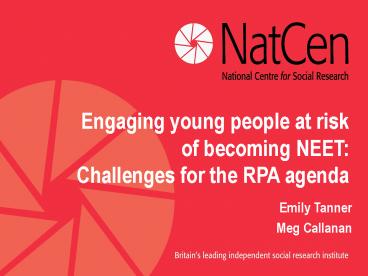Engaging young people at risk of becoming NEET: - PowerPoint PPT Presentation
1 / 16
Title:
Engaging young people at risk of becoming NEET:
Description:
... RR086 Meg Callanan, Rachel Kinsella, Jenny Graham, Ola Turkzuk, Steven Finch ... Emily Tanner, Susan Purdon, John D'Souza, Steven Finch ... – PowerPoint PPT presentation
Number of Views:78
Avg rating:3.0/5.0
Title: Engaging young people at risk of becoming NEET:
1
Engaging young people at risk of becoming NEET
Challenges for the RPA agenda
Emily Tanner Meg Callanan
2
The challenge of RPA
- Government committed to raising the participation
age to 17 by 2013 and 18 by 2015. - Approximately 10 of 16 and 17 year olds
currently NEET. - What does previous research tell us about NEET
young people? - 2 studies causes and consequences of
underachievement for 16-18s and impact of
Activity Agreement pilots for NEET 16-17s.
3
The study
- Pupils with declining attainment between Key
Stages 3 and 4 Profiles, experiences, and impact
of underachievement and disengagement (2009)
DCSF RR086 Meg Callanan, Rachel
Kinsella, Jenny Graham, Ola Turkzuk, Steven Finch
4
What were we trying to do?
- Explore characteristics of young people who
underachieve/disengage from education at KS4 - Explore causes of underachievement/disengagement
and perspectives on identifying disengagement and
providing effective support - Examine impact of disengagement on post-16
destinations, pathways choices
5
How did we do it?
- Quantitative analysis of administrative databases
(including the school census) to explore key
characteristics of this group - Qualitative in-depth interviews
- 17/18 yr olds sampled for a drop in achievement
between KS3 and KS4 - Parents
- School staff
6
Who are the young people who underachieve at KS4?
- Represent 5 of the cohort
- Underachievers are more likely to be
- Boys
- White
- from deprived background
- with Special Educational Needs
- NEET or JWT at 16/17
7
How does disengagement / underachievement happen?
- Crisis/event based
- Health/mental health problems, family breakdown,
bereavement, bullying, pregnancy - Gradual
- Often multiple factors feeding into process
e.g. curriculum, peer group, aspirations
8
What were their post 16 pathways?
- Range of post-16 destinations
- WBL, Employment, Further Education, NEET
- Shifting, fluid pathways
- NEET
- Diverse group (in and out of activity, caring
responsibilities, continuously NEET) - Barriers to participation included attainment at
KS4, self-confidence, aspirations, lack of
advice/support, finances, childcare
9
How can we re-engage the disengaged?
- High quality Information, Advice and Guidance
- Curriculum that matches aspirations and interests
with clear progression - Work based learning / apprenticeships
- Autonomy and choice
10
Activity Agreements Evaluation
- Financial incentives, intensive support and
brokered activities for long-term NEET 16-17 year
olds, overseen by DCSF. - Aimed to encourage YP back into education,
employment (preferably with learning) or
training. - 2 year programme from April 2006.
- 20 week programme.
- Evaluation carried out by IES, CEI and NatCen
impact, process and programme theory.
11
Who took part?
- 10,900 young people took part.
- Over 1/3 had irregular school attendance.
- Only 14 had 5 good GCSEs.
- Hardest to reach less likely to get involved.
- Participation lower than anticipated c.20 of
long-term NEET (or 45 of those who had heard of
AA) took part.
12
How did Activity Agreements work?
- The Activity Agreements triangle
- Activities flexible, wide-ranging, tailored.
- Adviser intensive support, the first step to
engagement. - Allowance a hook to get people involved.
- Underpinned by the Agreement something for
something - Route through AA influenced by prior attainment.
13
What difference did AA make?
- Positive impact on take-up of personal
development. - Positive impact on EET activities 3m later
(13ppt). - Positive impact on skills and confidence.
- Impact varies by prior attainment.
- higher attainers more likely to move to
work-based training and to have engaged in some
activity in the 12 months since becoming NEET. - Lower attainers more likely to engage in
learning.
14
What are the messages for engaging young people?
- Recognise diverse needs of disengaged young
people. - Provide targeted intensive support during last
years of school and beyond. - Offer flexible, tailored activities that allow
autonomy and match aspirations.
15
Reports
- Pupils with declining attainment between Key
Stages 3 and 4 Profiles, experiences, and impact
of underachievement and disengagement (2009)
DCSF RR086 Meg Callanan, Rachel Kinsella, Jenny
Graham, Ola Turkzuk, Steven Finch - Activity Agreement Pilots Evaluation Synthesis
Report (2008) DCSF RR063 Jim Hillage, Claire
Johnson, Becci Newton, Sue Maguire, Emily Tanner,
Susan Purdon - Evaluation of Activity Agreement Pilot Report of
the Quantitative Evaluation (2009, forthcoming)
DCSF.
Emily Tanner, Susan Purdon, John DSouza, Steven
Finch
16
(No Transcript)































